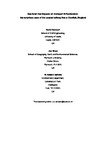Sea-level rise impacts on transport infrastructure: The notorious case of the coastal railway line at Dawlish, England
| dc.contributor.author | Dawson, D | |
| dc.contributor.author | Shaw, Jon | |
| dc.contributor.author | Gehrels, R | |
| dc.date.accessioned | 2016-07-13T12:42:07Z | |
| dc.date.available | 2016-07-13T12:42:07Z | |
| dc.date.issued | 2016-02 | |
| dc.identifier.issn | 0966-6923 | |
| dc.identifier.issn | 1873-1236 | |
| dc.identifier.uri | http://hdl.handle.net/10026.1/5053 | |
| dc.description.abstract |
Future climate change is likely to increase the frequency of coastal storms and floods, with major consequences for coastal transport infrastructure. This paper assesses the extent to which projected sea-level rise is likely to impact upon the functioning of the Dawlish to Teignmouth stretch of the London to Penzance railway line, in England. Using a semi-empirical modelling approach, we identify a relationship between sea-level change and rail incidents over the last 150 years and then use model-based sea-level predictions to extrapolate this relationship into the future. We find that days with line restrictions (DLRs) look set to increase by up to 1170%, to as many as 84–120 per year, by 2100 in a high sea-level rise scenario (0.55–0.81 m). Increased costs to the railway industry deriving from maintenance and line restrictions will be small (£ millions) in comparison with damage caused by individual extreme events (£10s of millions), while the costs of diversion of the railway are higher still (£100s of millions to billions). Socio-economic costs to the region are likely to be significant although they are more difficult to estimate accurately. Finally, we explain how our methodology is applicable to vulnerable coastal transport infrastructure worldwide. | |
| dc.format.extent | 97-109 | |
| dc.language | en | |
| dc.language.iso | en | |
| dc.publisher | Elsevier | |
| dc.subject | Climate change | |
| dc.subject | Adaptation | |
| dc.subject | Resilience | |
| dc.subject | Semi-empirical | |
| dc.subject | Rail network | |
| dc.subject | Economic impact | |
| dc.title | Sea-level rise impacts on transport infrastructure: The notorious case of the coastal railway line at Dawlish, England | |
| dc.type | journal-article | |
| dc.type | Article | |
| plymouth.author-url | https://www.webofscience.com/api/gateway?GWVersion=2&SrcApp=PARTNER_APP&SrcAuth=LinksAMR&KeyUT=WOS:000375505200011&DestLinkType=FullRecord&DestApp=ALL_WOS&UsrCustomerID=11bb513d99f797142bcfeffcc58ea008 | |
| plymouth.volume | 51 | |
| plymouth.publication-status | Published | |
| plymouth.journal | Journal of Transport Geography | |
| dc.identifier.doi | 10.1016/j.jtrangeo.2015.11.009 | |
| plymouth.organisational-group | /Plymouth | |
| plymouth.organisational-group | /Plymouth/Faculty of Science and Engineering | |
| plymouth.organisational-group | /Plymouth/Faculty of Science and Engineering/School of Geography, Earth and Environmental Sciences | |
| plymouth.organisational-group | /Plymouth/REF 2021 Researchers by UoA | |
| plymouth.organisational-group | /Plymouth/REF 2021 Researchers by UoA/UoA14 Geography and Environmental Studies | |
| plymouth.organisational-group | /Plymouth/Users by role | |
| plymouth.organisational-group | /Plymouth/Users by role/Academics | |
| dcterms.dateAccepted | 2015-11-28 | |
| dc.identifier.eissn | 1873-1236 | |
| dc.rights.embargoperiod | Not known | |
| rioxxterms.versionofrecord | 10.1016/j.jtrangeo.2015.11.009 | |
| rioxxterms.licenseref.uri | http://www.rioxx.net/licenses/all-rights-reserved | |
| rioxxterms.licenseref.startdate | 2016-02 | |
| rioxxterms.type | Journal Article/Review |


